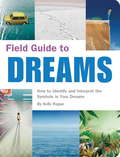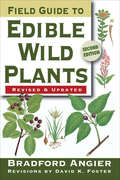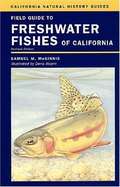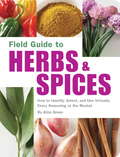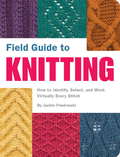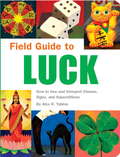- Table View
- List View
Field Guide to Acadia National Park, Maine
by Russell D. ButcherThe 42,000 acres that comprise Acadia National Park include glacier-worn granite mountains, rocky cliffs, crystal blue ponds and lakes, and a dramatic coastline where waves collide spectacularly with dramatic headlands. This book describes the flora, fauna, and geology of the park, as well as a number of the prominent trails that take you in and around some of the most charming scenery in North America.
Field Guide to Amphibians and Reptiles of Illinois
by Christopher A. Phillips John A. Crawford Andrew R. KuhnsThe second edition of the Field Guide to Amphibians and Reptiles of Illinois offers up-to-date information on the state’s 102 species of frogs and toads, salamanders, turtles, lizards, and snakes. Detailed descriptions by the authors include habitats, distinguishing features, behaviors, and other facts, while revised range maps and full-color photographs help users recognize animals in the field. In addition, an identification key and easy-to-navigate page layouts guide readers through extensive background material on each species' population, diet, predators, reproduction, and conservation status. A one-of-a-kind resource, the Field Guide to Amphibians and Reptiles of Illinois is a definitive guide aimed at biologists, teachers, students, wildlife specialists, natural resource managers, conservationists, law enforcement officials, landowners, hobbyists, and everyone else eager to explore herpetology and nature in the Prairie State.
Field Guide to Candy
by Anita Chu Tucker HoslerAt last, a field guide to making and identifying virtually every candy imaginable, from peanut-butter cups to mint meltaways! Field Guide to Candy is the definitive guide to candies from around the world, with more than 100 recipes and variations on such tried-and-true classics as caramel apples, rocky road, and lollipops as well as traditional international favorites like Turkish delight, truffles, and French pralines. This delectable guide introduces readers to the best techniques for creating chocolates; sugary sweets; creamy, sticky, chewy candies; nutty treats; and fun and simple classics. Every candy is photographed in glorious full color, with step-by-step instructions on how to prepare, make, and store your creations. Entries include fascinating historical background, helpful baking notes, and serving suggestions for each delicious variety. Whether you're a candy-making novice or veteran pastry chef, mouth-watering homemade confections are minutes away with Field Guide to Candy!
Field Guide to Cocktails
by Rob ChiricoFinally, a field guide to preparing and identifying virtually every drink at the bar, from the Añejo Highball to the Caipirinha, from the Singapore Sling to the Zombie! Field Guide to Cocktails is not an ordinary bartender's guide. Here are more than 200 recipes for the world's best libations, with tried-and-true classics like the Tom Collins and the Fuzzy Navel and contemporary favorites like the Mojito and the Cosmopolitan. Full-color photographs of the cocktails are cross referenced to in-depth descriptions of the drinks. The histories are the stuff of legend: The Gin Rickey was mixed up to satisfy a thirsty lobbyist; Grog was drunk by sailors in the British Navy to prevent scurvy; and the Gibson was originally just a glass of water with an onion in it. You'll also learn the most appropriate time and season to enjoy the drink, and you'll get suggestions for the perfect food pairings--lobster with a Cape Codder, sharp cheese and crackers with a Gin and Tonic, black bean dip and chips with a Cuba Libre, and more. So whether you're planning a cocktail party or trying to identify a new drink to try at the bar, Field Guide to Cocktails is the only mixology book you'll ever need. Cheers!
Field Guide to Cookies
by Anita Chu Caroline RomanskiAt last, a field guide to baking and identifying virtually every cookie imaginable, from Snickerdoodles to Pfeffernusse! Field Guide to Cookies is the definitive guide to cookies from around the world, with more than 100 recipes and variations on such tried-and-true classics as gingersnaps, whoopie pies, and pinwheels as well as traditional international favorites like pizzelles, baklava, and alfajores. This delectable guide introduces readers to the best techniques for creating drop, bar, molded, rolled, and sandwich variations. Every cookie is photographed in glorious full color, with step-by-step instructions on how to prepare, bake, and store your creations. Entries include fascinating historical background, helpful baking notes, and serving suggestions for each delicious variety. Whether you're a baking novice or veteran pastry chef, mouthwatering home-baked confections are just minutes away with Field Guide to Cookies!
Field Guide to Dreams
by Kelly ReganAt last, a field guide to identifying and interpreting dream symbols, from falling to flying! Dreams can be mysterious, exhilarating, and terrifying--but they don't have to be confusing. With Field Guide to Dreams, you'll unravel the hidden meanings behind these mysterious subconscious messages. For example, you may find yourself naked in front of your high school classroom during a time of great change--perhaps you're feeling insecure about a decision you recently made. Of if you find buried treasure in a dream, you may have hidden talents or knowledge. Organized by dominant symbol (animals, caves, hospitals, teachers, and so on), each full-color image refers to a complete dream description. This book gives you clues to a dream's meaning and explains the significance of having the same dream time and again. You'll hear what Freud and Jung might say about a particular vision and discover a dream's sometimes strange, often illuminating, historical and cultural context. With Field Guide to Dreams at your bedside, you'll never wonder if that cigar was just a cigar!
Field Guide to Edible Wild Plants
by Bradford AngierRevised and updated: The classic illustrated reference for today&’s foragers. With essential information on each plant&’s characteristics, distribution, and edibility, as well as updated taxonomy and eighteen new species, this is the second edition of Field Guide to Edible Wild Plants—the practical handbook for finding, preparing, and eating plants growing in the wild. This guide to North American wild edibles has been a nature classic for over thirty years. Now David K. Foster revises Bradford Angier&’s invaluable foraging reference. Scientific information for a general audience and full-color illustrations combine with intriguing accounts of the plants&’ uses, making this a practical and informative resource for modern-day foragers.
Field Guide to Freshwater Fishes of California (Revised Edition)
by Samuel M. McginnisThis book is a field guide to all of California's 130 freshwater fish species, both native and introduced. Revised and updated throughout, the guide features the complete collection of color illustrations of California freshwater fishes available anywhere. These color illustrations, coupled with a set of highly detailed black-and-white drawings, provide a quick and easy method for identifying fish in the field.
Field Guide to Gestures
by Nancy Armstrong Melissa WagnerFinally, a field guide to interpreting more than 100 international gestures, from the wave to the finger, from the shrug to the nod. Here's easy access to the essential information about common (and some not-so-common) gestures you may encounter at home or abroad. Field Guide to Gestures is organized into handy sections for quick reference when time is of the essence and interpretation is everything. If a man bends his torso forward when meeting you, turn to the "Arrival/Departure" chapter to learn more about the bowing gesture. When the woman at the end of the bar flips her hair and looks your way, turn to the "Mating" chapter to learn just what she's trying to say. And if your friend has intertwined his index finger and middle fingers as the night's lottery numbers are being read, go to "No Words Needed" to learn more about the crossed fingers gesture. This practical guide includes more than 100 full-color photographs of the world's most common gestures, plus cross-referenced descriptions throughout, including historical background and common usage. Helpful step-by-step directions and detailed line drawings teach you how to perform each gesture correctly.
Field Guide to Grasses of the Mid-Atlantic (Keystone Books)
by Sarah ChamberlainGrasses are among the most ubiquitous plants on the planet. They inhabit a wide geographic range and are found in a variety of natural habitats. The small parts of the grass flower and specialized terminology, however, can make identifying grasses a challenging endeavor. Sarah Chamberlain’s Field Guide to Grasses of the Mid-Atlantic makes identification simpler for everyone—regardless of their previous botanical knowledge.Featuring an easy-to-use dichotomous key, this is a user-friendly guide to more than 300 types of grasses found from the Blue Ridge Mountains and southern plains to the Appalachians and the Allegheny Plateau. Each major entry contains detailed species diagrams as well as common names, habitats, and distribution. The book’s opening sections outline the parts of grass flowers and describe stem, leaf, and sheath characteristics.With a wealth of illustrations, instructions on how to use the key, and a glossary of terms, Field Guide to Grasses of the Mid-Atlantic is an indispensable reference for naturalists and conservationists, botanists, land management professionals, and students and scholars of mid-Atlantic flora.
Field Guide to Grasses of the Mid-Atlantic (Keystone Books)
by Sarah ChamberlainGrasses are among the most ubiquitous plants on the planet. They inhabit a wide geographic range and are found in a variety of natural habitats. The small parts of the grass flower and specialized terminology, however, can make identifying grasses a challenging endeavor. Sarah Chamberlain’s Field Guide to Grasses of the Mid-Atlantic makes identification simpler for everyone—regardless of their previous botanical knowledge.Featuring an easy-to-use dichotomous key, this is a user-friendly guide to more than 300 types of grasses found from the Blue Ridge Mountains and southern plains to the Appalachians and the Allegheny Plateau. Each major entry contains detailed species diagrams as well as common names, habitats, and distribution. The book’s opening sections outline the parts of grass flowers and describe stem, leaf, and sheath characteristics.With a wealth of illustrations, instructions on how to use the key, and a glossary of terms, Field Guide to Grasses of the Mid-Atlantic is an indispensable reference for naturalists and conservationists, botanists, land management professionals, and students and scholars of mid-Atlantic flora.
Field Guide to Herbs and Spices
by Aliza GreenField Guide to Herbs & Spices will forever change the way you cook. With this practical guide--including full-color photographs of more than 200 different herbs, spices, and spice mixtures--you'll never again be intimidated or confused by the vast array of spices available. Learn to discern the differences between the varieties of basil, the various colors of sesame seeds, the diverse types of sugar and salt, and even how to identify spice pastes like zhoug, harissa, and achiote. Each entry features a basic history of the herb or spice (saffron used to be worth more than gold!), its season (if applicable), selection and preparation tips, a recipe featuring the seasoning, and some suggested flavor pairings. Complete with more than one hundred recipes, Field Guide to Herbs & Spices is a must-have resource for every home cook. Meals will never be the same again!
Field Guide to Knitting
by Jackie PawlowskiAt last, a field guide to identifying and working more than 200 knitting stitches, from stockinette to Orenburg lace! There are so many intriguing ways to knit yarn that it's often tough to pick the right stitch. Help is on the way with Field Guide to Knitting, the stitch dictionary that belongs in every knitting bag. This handy go-to reference book takes a comprehensive look at knit and purl stitches as well as cables, laces, ribs, and edge treatments. Learn to tell k2togs from ssks and to differentiate between ribbed basketweave and basket cable. Each entry reveals the history of the stitch, the best stitch gauge for achieving pattern definition, the garments most suited to the pattern, and more. Complete patterns for executing the stitch (and its variations) are also included. More than 200 full-color photographs make it easy to compare how stitches will look before committing yarn to needles. Whether you just need to know if moss stitch is the same as seed stitch or you're planning a complicated Aran sweater, Field Guide to Knitting has all the answers.
Field Guide to Luck
by Alys R. YablonTake Control of Your Destiny! From the good luck provided by shamrocks, rabbits's feet, and horseshoes to the misfortune caused by broken mirrors, black cats, and umbrellas opened indoors, our lives are filled with signs and superstitions that guide our destiny and influence our fate. Fortunately, Field Guide to Luck can help you recognize dozens of influential charms, dates, sayings, and symbols wherever you encounter them. Learn what objects are on your side, which practices are best avoided, and where these curious beliefs come from. This indispensable guide reveals their fascinating origins and offers tips for putting them into practice. With Lady Luck on your side and a lucky penny in your pocket, you're sure to lead a charmed life!
Field Guide to Meat
by Aliza GreenAt last, a field guide to identifying and selecting more than 200 different cuts and kinds of meat, from beef and poultry to game and cured meat! An essential resource for every home cook or chef, Field Guide to Meat offers details on virtually every kind of meat available. This practical guide includes more than 200 full-color photographs of cuts of beef, veal, pork, lamb, game, and poultry as well as more than 100 different kinds of cured meats and sausages. Cross-referenced with the photographs are in-depth descriptions of the cuts, including basic history, location in the animal, characteristics, information on how to choose the cut, and flavor affinities. Step-by-step preparation directions tell you whether the item is best marinated, braised, grilled, roasted, or pan-seared. Trips to the butcher's aisle will no longer be intimidating, and you'll never end up with a cut that's too tough for dinner.
Field Guide to Medicinal Wild Plants
by Bradford AngierA revision of the definitive reference, containing plant characteristics, distribution, and medicinal qualities, an updated taxonomy, and fifteen new species. The Field Guide to Medicinal Wild Plants is the ultimate handbook for identifying and using wild plants for medicinal purposes. This illustrated guide to North American wild medicinals has been a nature classic for over thirty years. In this second edition, David K. Foster revises Bradford Angier's invaluable reference, updating the taxonomy and adding more than a dozen species, including the purple coneflower, popularly known as echinacea, as well as ephedra, jewelweed, goldenseal, and more. Scientific information for a general audience and full-color illustrations combine with intriguing accounts of the plants&’ uses, making this a practical guide for anyone interested in the medicinal uses of wild plants.
Field Guide to North American Truffles: Hunting, Identifying, and Enjoying the World's Most Prized Fungi
by James M. Trappe Frank Evans Matt TrappeThe second most expensive food in the world after saffron, truffles are treasured, coveted, and savored for their mysterious and exotic flavor. This complete field guide shows chefs and fungi aficionados how to forage for and identify the wide variety of truffles that grow in temperate forests throughout North America. Written by expert horticulturalists who have studied, classified, and enjoyed truffles for decades, the FIELD GUIDE TO NORTH AMERICAN TRUFFLES makes these celebrated underground jewels accessible to all. The first full-color illustrated guide to identifying North American truffles by their key features, including profiles of more than 80 species of truffles. Includes more than 80 photographs of rare and hard-to-find truffle species. Features flavor profiles, delectability index, and culinary tips for each species. Perfect size for carrying in a pocket or daypack.Reviews"It'¬?s the first book of its kind, complete with photographs, cross-sectional views of indigenous truffle varieties, guides to seasonal availability, and foraging tips for hundreds of kinds of truffles (both the edible and inedible kinds), as well as tasting notes and cooking tips."-SaveurFrom the Trade Paperback edition.
Field Guide to Poison Ivy, Poison Oak, and Poison Sumac: Prevention And Remedies
by Susan Carol HauserThis handbook takes the mystery out of identifying these common weeds and provides useful antidotes for treating their irritating, itching rashes. Photos show the plants in every season, and detailed drawings help readers pinpoint the culprit in the woods or in their own backyards. Hauser distinguishes between home remedies that really work and those that can actually aggravate the poison, tells how to treat each poison differently, and explains how to prevent the offending vines from growing in the yard. The perfect reference for homeowners, parents, gardeners and hikers, this is easy to read and informative. Susan Carol Hauser is a writer and gardener who lives in Bemidji, Minnesota.
Field Guide to Produce
by Aliza GreenAt last, a field guide to identifying and selecting more than 200 fruits and vegetables from around the world! The perfect companion for every shopper, Field Guide to Produce offers tips for selecting, storing, and preparing everything from apples to zucchini. When an unfamiliar edible appears on your grocer's shelf, simply flip through the full-color insert until you've found its photograph. Turn to the corresponding page to discover its country of origin, common uses, and season of harvest. This practical guide includes more than 200 full-color photographs of the world's most popular fruits and vegetables, cross-referenced to in-depth descriptions and selection tips. Step-by-step preparation directions tell you whether the item must be peeled, washed, trimmed, or blanched. Grocery shopping--and dinner--will never be the same again!
Field Guide to Seafood
by Aliza GreenAt last, a field guide to identifying and selecting seafood from around the world, including barramundi, lobsterette, wahoo, and more! With the daunting array of fish and shellfish available in today's market, Field Guide to Seafood is a must-have for every seafood consumer! This helpful guide offers a comprehensive look at seafood, covering more than 100 different kinds of fish and shellfish, plus preserved fish, fish sauces, and caviar. Learn to differentiate between Arctic char and salmon or between snow crabs and stone crabs with the in-depth descriptions and full-color photographs. Each entry contains a list of alternate names, characteristics, and suggested preparation, including directions on when to remove or leave the skin. Step-by-step instructions explain how to identify, store, and cook the item. Whether your fish is store-bough or just caught, this guide includes selection tips, suggested recipes, and complementary flavors. You'll never feel overwhelmed by the wide variety of seafood with this handy guide -- don't go shopping without it!
Field Guide to Stains: How to Identify and Remove Virtually Every Stain on Earth (Field Guide)
by Nancy Armstrong Melissa Wagner Virginia M. FriedmanAt last, a field guide to identifying and doing battle with more than 100 stains, from tomato juice to tar, from avocado to urine! Field Guide to Stains is divided into handy sections for easy access to information when time is of the essence: Fruits and Vegetables, Meat and Protein, Household Items, Garage and Yard, and more. Readers will learn more than just removal techniques--details include general descriptions and likely seasons, times, and areas of occurrence. Did you know that a yogurt stain is more likely to occur in January (when New Year's resolutions demand more healthy eating), and that correction fluid stains are more prevalent in April (when the pressure to complete your taxes on time is at a high)? Includes more than 100 full-color photographs of stains, each one cross-referenced to its description and step-by-step removal advice. Quick-reference icons guide the reader to the most essential information in each entry. This guide has a sturdy, stain-proof exterior--making it a necessity for every cubicle, glove compartment, and college dorm. Field Guide to Stains is a must-have for everyone about to venture out into the wild, to the kitchen, or to a night on the town!
Field Guide to Street Trees New York City
by Leslie Day“A handbook for naturalists, sidewalk denizens, apartment dwellers, dog-walkers, and bicycle riders . . . No New Yorker should be without this book.” —Wayne Cahilly, New York Botanical GardenNew York City is an urban oasis with hundreds of thousands of trees, and this guide acquaints residents and visitors alike with fifty species commonly found in the neighborhoods where people live, work, and travel. Beautiful, original drawings of leaves and stunning photographs of bark, fruit, flower, and twig accompany informative descriptions of each species. Detailed maps of the five boroughs identify all of the city’s neighborhoods, and specific addresses pinpoint where to find a good example of each tree species.Trees provide invaluable benefits to the Big Apple: they reduce the rate of respiratory disease, increase property values, cool homes and sidewalks in the summer, block the harsh winds of winter, clean the air, absorb storm water runoff, and provide habitat and food for the city’s wildlife. Bald cypress, swamp oak, silver linden, and all of New York’s most common trees are just a page turn away. Your evening walk will never be the same once you come to know the quiet giants that line the city’s streets.
Field Guide to Tools
by John KelseyFinally, a field guide to identifying and utilizing more than 100 tools, from an awl to a propane torch, from a table saw to a screwdriver! Field Guide to Tools is the ultimate guide to all the gear any handyperson requires. Hardware stores, home stores, and garden stores are full of unrecognizable items--here's how you can find out what tool is appropriate for your job and just how to go about employing it. Descriptive pages outline the basic history and use for each tool, inventive alternate functions, and operating principles; component parts are illustrated by helpful diagrams; and more than 100 full-color photographs aid in identification while at the hardware store. Step-by-step directions walk you through the basics of using each tool properly and safely. Don't attempt another at-home fix-it project without Field Guide to Tools!
Field Guide to Wild Mushrooms of Pennsylvania and the Mid-Atlantic (Keystone Books)
by Bill RussellTo most Americans, mushrooms are the brown lumps in the soup one uses to make a tuna casserole, but to a select few, mushrooms are the abundant yet often well-hidden delicacies of the forests. In spite of their rather dismal reputation, most wild mushrooms are both edible and delicious, when prepared properly. From the morel to the chanterelle and the prolific and aptly named chicken of the woods, mushrooms can easily be harvested and enjoyed, if you know where to look and what to look for. Bill Russell’s Field Guide to the Wild Mushrooms of Pennsylvania and the Mid-Atlantic helps the reader learn just that—specifically for the often-neglected East Coast mushrooms of the United States and Canada.Suited to both the novice and the experienced mushroom hunter, this book helps the reader identify mushrooms with the use of illustrations, descriptions, and environmental observations. Russell’s fifty years of experience in hunting, studying, and teaching about wild mushrooms have been carefully distilled into this easy-to-use and well-designed guide. The book is divided into the four seasons, each with its unique mushroom offerings. Each mushroom section includes a detailed description, information about the mushroom’s biology, tips on where the mushroom is most likely to be found, and a short “nutshell” description for quick reference. The book also includes color photographs of each of the mushrooms described.Russell’s Field Guide to the Wild Mushrooms of Pennsylvania and the Mid-Atlantic shows the reader not only how to identify the most common mushrooms found in the region but also how to avoid common copycats—and what to do with the mushrooms once they’re identified and harvested. With both color illustrations and insightful descriptions of one hundred of the area’s most common mushrooms, Field Guide is an indispensable reference for the curious hiker, the amateur biologist, or the adventurous chef.
Field Guide to Wild Mushrooms of Pennsylvania and the Mid-Atlantic: Revised and Expanded Edition (Keystone Books)
by Bill RussellThis revised and expanded edition of mushroom expert Bill Russell’s popular Field Guide to Wild Mushrooms of Pennsylvania and the Mid-Atlantic provides both novice and experienced mushroom foragers with detailed, easy-to-use information about more than one hundred species of these fungi, including twenty-five varieties not found in the previous guide.From the Morel to the Chanterelle to the aptly named Chicken of the Woods, mushrooms of the mid-Atlantic region can be harvested and enjoyed, if you know where to look. Each entry in this field guide contains a detailed description, current scientific classification, key updates and information from recent studies, and high-quality color photographs to aid in identification. Thoughtfully organized by season, the guide shows you how to locate and identify the most common mushrooms in the region and recognize look-alikes—and explains what to do with edible mushrooms once you’ve found them.Featuring over one hundred full-color illustrations and distilling Russell’s fifty years of experience in hunting, studying, and teaching about wild mushrooms, Field Guide to Wild Mushrooms of Pennsylvania and the Mid-Atlantic is an indispensable reference for curious hikers, amateur biologists, adventurous chefs, and mycophiles of all stripes.





